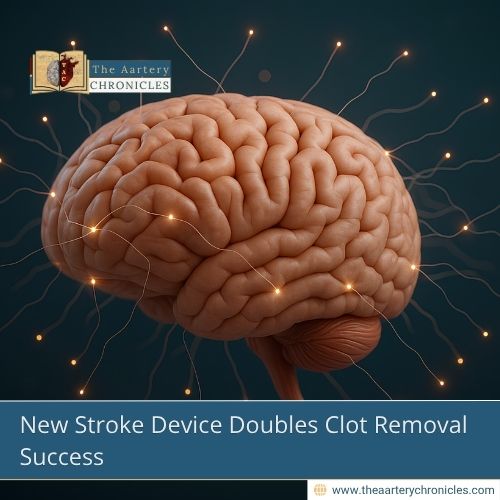

New Stroke Device Doubles Clot Removal Success
Summary: Stanford researchers have developed the milli-spinner thrombectomy, a groundbreaking device that safely compacts and removes blood clots using compression and shear forces. This innovation more than doubles success rates in stroke treatment, especially for tough clots. With potential uses in clearing kidney stones and other blockages, this device is set to revolutionize clot removal therapies.
New Stroke Treatment Could Be a Major Breakthrough
Did you know stroke kills one person every 40 seconds? In ischemic stroke, the most common type, a clot blocks blood flow to the brain, and every second without treatment means more brain cells lost. But now, a breakthrough from Stanford University could transform how doctors treat stroke and blood clots.
Introducing the milli-spinner thrombectomy: a revolutionary device that compacts clots using smart mechanics to remove them faster and more effectively, more than doubling first-attempt success rates.
The Challenge: Treating Ischemic Stroke Quickly
Ischemic stroke happens when a clot blocks a brain artery, cutting off oxygen. Immediate removal is critical, but current treatments are only effective 50% of the time on the first attempt and fail in approximately 15% of cases.
The Milli-Spinner: A Revolution in Clot Removal
Developed by Stanford researchers, the milli-spinner thrombectomy uses a clever combo of compression and shear forces to shrink and remove clots. In early tests, the device performed significantly better than standard tools.
“For the toughest clots…we’re opening the artery on the first try 90% of the time,” says Dr. Jeremy Heit, Chief of Neuroimaging at Stanford. “It’s unbelievable.”
How It Works: Shrinking Clots Without Breaking Them
Clots are formed by fibrin, a tough protein that binds blood cells into a sticky mess. Traditional devices try to break or vacuum the clot, often causing pieces to escape and lodge elsewhere.
The milli-spinner does it differently. It’s a spinning, hollow catheter with fins and slits that apply:
- Compression – pressing the clot inward
- Shear – spinning motion that coils fibrin threads into a tight ball
This allows for clean, complete clot removal without fragmenting it.
“It dramatically reduces clot volume without causing rupture,” says mechanical engineer Dr. Renee Zhao, lead author of the study.
Proof in Research: Lab and Animal Tests Show Big Results
In controlled studies, the milli-spinner shrank clots to just 5% of their original size and allowed red blood cells to flow again. It worked on all kinds of clots, including tough, fibrin-rich ones that current tools can’t handle.
A Discovery by Accident: “It Felt Like Magic”
Interestingly, this design grew out of Zhao’s work with tiny millirobots meant to swim through the body. Initially meant for movement, the spinning structure showed unexpected suction effects, perfect for pulling in and compacting clots.
“We observed a striking colour change and dramatic volume reduction,” says Zhao. “It felt like magic.”
Beyond Stroke: More Medical Uses in Sight
The milli-spinner’s powerful suction may go far beyond stroke treatment:
- Kidney stone removal
- Other vascular blockages
- Untethered robotic versions that could travel inside the body
“We’re exploring other biomedical applications and even non-medical ones,” Zhao adds.
What’s Next: Getting This Into Hospitals
To bring this life-saving tool to patients, the Stanford team has started a new company and plans to begin clinical trials soon.
“We’re working to bring this into clinical settings,” says Zhao. “It could significantly boost the success rate of thrombectomy procedures and save lives.”
Conclusion: A New Era for Stroke and Clot Treatment
The milli-spinner thrombectomy doesn’t just remove clots, it reshapes and compacts them with unmatched precision. This innovation could dramatically improve outcomes for stroke patients and offer new hope for those with clot-related diseases.
If approved, this could redefine stroke treatment as we know it and open doors to other life-saving therapies.
Reference: Yilong Chang, Shuai Wu, Qi Li, Benjamin Pulli, Darren Salmi, Paul Yock, Jeremy J. Heit and Ruike Renee Zhao et al. Milli-spinner thrombectomy. Nature volume 642, pages336–342 (2025)

Dane
I am an MBBS graduate and a dedicated medical writer with a strong passion for deep research and psychology. I enjoy breaking down complex medical topics into engaging, easy-to-understand content, aiming to educate and inspire readers by exploring the fascinating connection between health, science, and the human mind.








